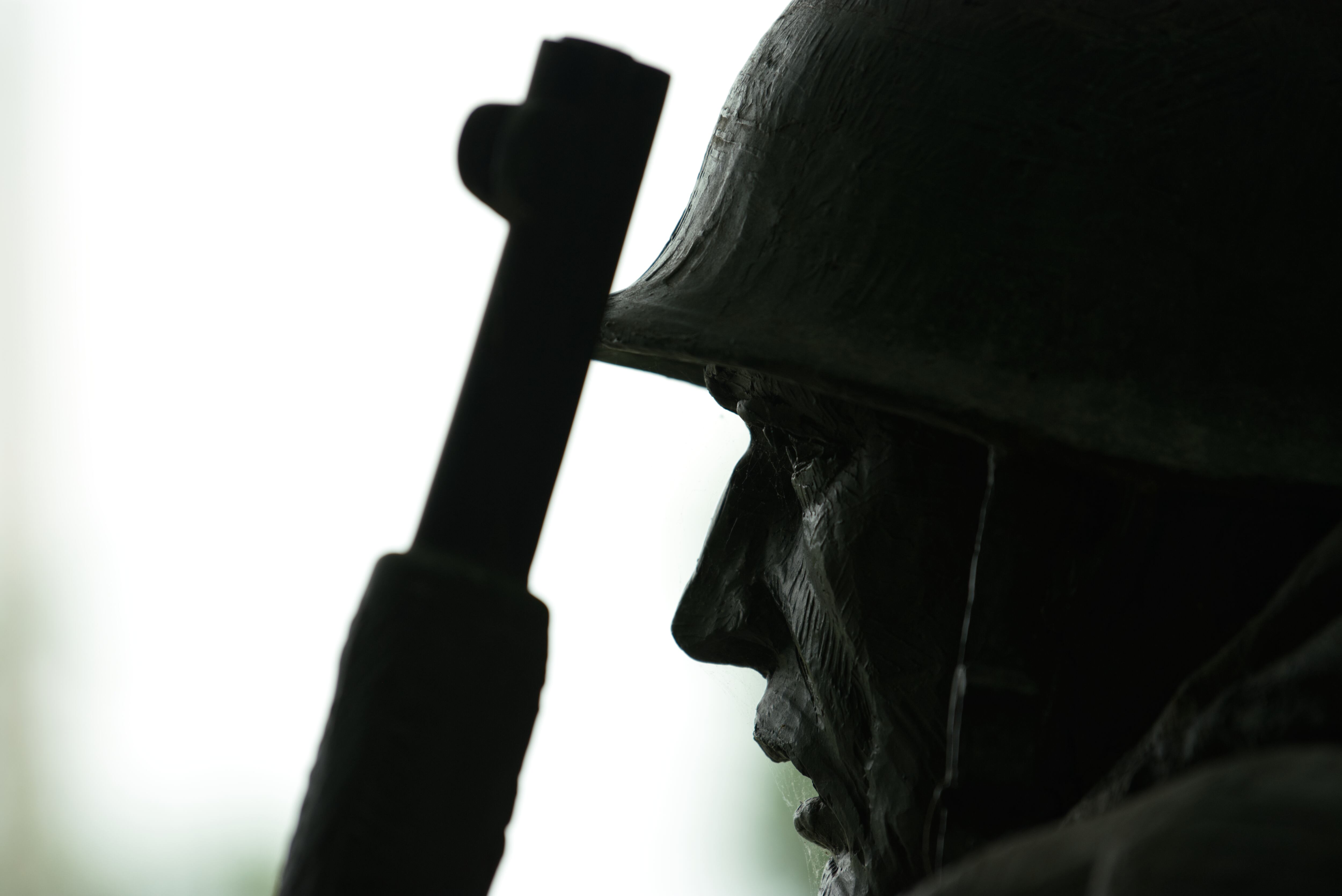Sometimes tragedy compounds.
A young soldier from Mexico, Pvt. Ana Basaldua Ruiz, died on March 15, according to a release posted to the Fort Cavazos Media Center. Her family told the media that officials suspected suicide.
And in death, her name was incorrectly formatted as “Basalduaruiz,” leading a number of news organizations to replicate the error. The mistake combined her father’s family name with that of her mother.
But in the Army’s eyes, that was her name; a spokesperson for the 1st Cavalry Division confirmed the name came directly from her official personnel file.
From punch cards to press releases, the Army’s personnel systems have struggled to render special characters — like the space in Basaldua Ruiz’s name — for decades, mangling memories, identities and heritage in the process.
While the Army said a recent human resources system upgrade will fix the issue moving forward, the service’s record-keeping policies and database technological constraints stripped such characters and “closed up” compound names. Other names were cut off. The problem disproportionately impacts Latino and Native American soldiers, whose compound surnames often include spaces.
The repercussions aren’t merely a matter of identity or honor, either. Lawmakers and the Defense Department are working through who will fix misspelled names on the Korean War Veterans Memorial’s new Wall of Remembrance, which advocates say could be more than 1,000 names. It’s still not clear who will foot the bill for the errors in the $22 million wall.
The mistakes, which echo the Army’s past struggles to accurately record such names in its personnel systems, further outraged lawmakers who reviewed Military Times’ findings. They emphasized the importance of getting names right and committed to solving the errors.
‘Close up’ hyphenated names
The surname errors for soldiers listed on the Wall of Remembrance likely emerged from policy decisions shaped by technological constraints and a high volume of deaths, according to archival documents reviewed by Military Times. Digital archivist Jefferson Bailey first posted the documents online in a 2014 academic paper.
When World War II began, the Army manually tracked unit rosters and casualties through legions of typists, according to a November 1945 research study by the service’s European theater headquarters. But as the death toll mounted, the service adopted machine-readable punch cards as a way to efficiently track each fallen soldier and notify their families.
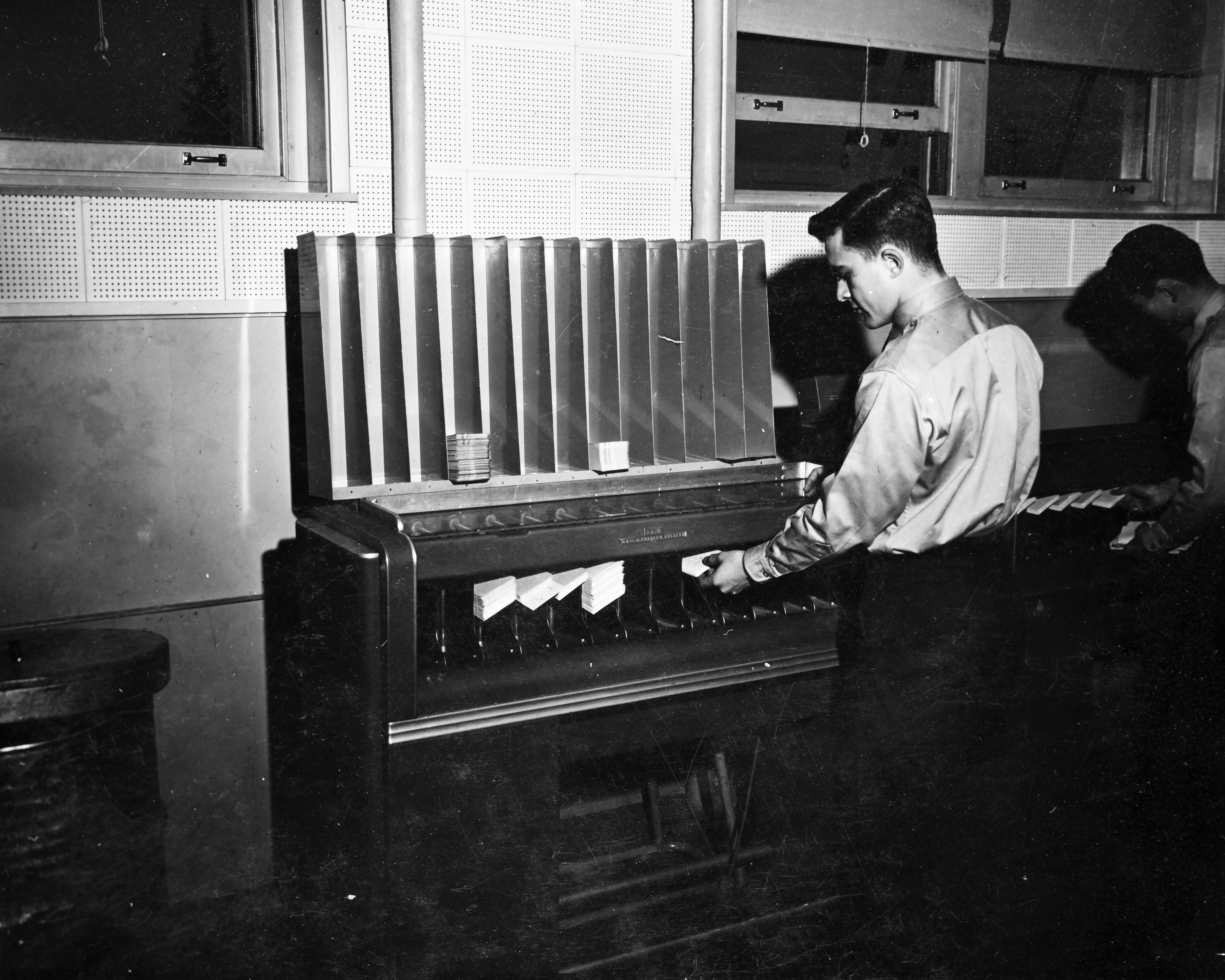
By the time war broke out in Korea in 1950, Army casualty punch cards were down to a faulty science, including a list of guidelines on how to input names.
The card’s 18-character name field had little room to spare, so operators had strict marching orders:
- “No spaces within surname or first name;”
- “No punctuation marks in name, such as: commas, periods, apostrophes, etc.;”
- “Close up hyphenated names.”
By the war’s end, nearly 110,000 punch cards sat in filing cabinets in the Adjutant General’s Office.
Even when databases are upgraded — such as when the Army’s so-called TAGOKOR casualty file was digitized in the 1960s and then reformatted by the National Archives multiple times since — the information inside them retains the constraints of its original format.
In other words, moving truncated names into a new system doesn’t restore their original form.
In fact, data entry policies from the TAGOKOR records mirror the errors found in today’s Korean War casualty lists, though Military Times could not independently trace the sources of the wall’s list further back than the 1980s. The modern-day Defense Casualty Analysis System’s historical conflict listings came from the Washington Headquarters Service’s Worldwide Casualty System, but it’s not clear what specific systems fed data into the Worldwide Casualty System when it emerged 40 years ago.
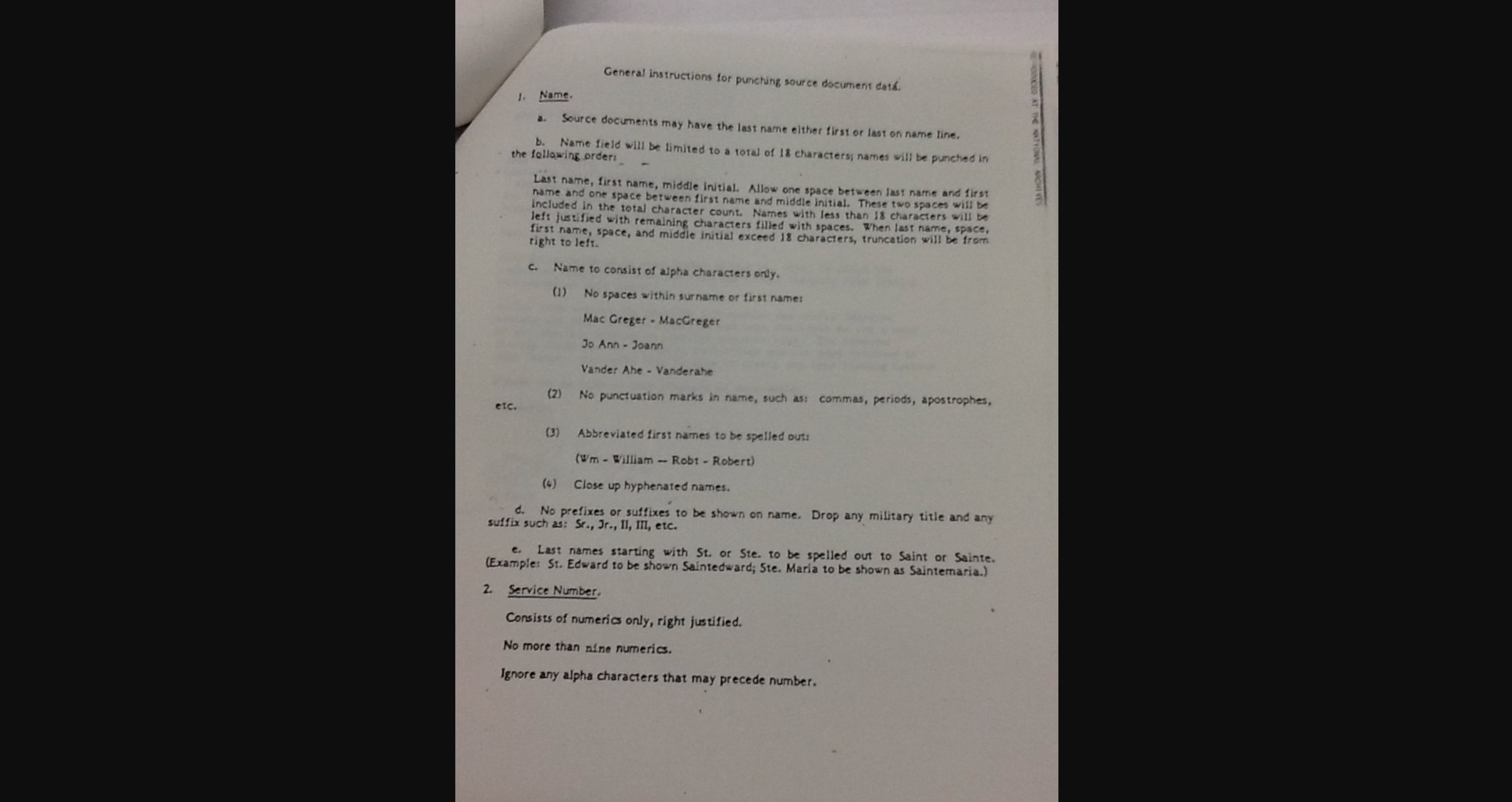
In 2021, Military Times was the first to report that the Korean War Wall of Remembrance could have thousands of errors due to lingering misspelling and formatting problems. But both the Defense Department and the foundation overseeing the Wall’s construction argued the law authorizing the memorial left them powerless to change the spelling of the names.
The Vietnam Veterans Memorial wall solved the name issue through sheer willpower; in his memoir, Jan Scruggs, an Army veteran who was instrumental in the Vietnam wall’s creation, recounted the “major challenge” of reformatting the names of the dead from the original list that the Pentagon provided.
Yet the long-running debate over the names on the Vietnam wall — and the process of adding new names to it since it was originally carved — led to the odd arrangement for the Korea wall’s names, according to the New York Times. The Defense Department set eligibility criteria and sent names to the Korean War Veterans Memorial Foundation, and the foundation was legally obligated to submit any requested changes to the Pentagon for approval.
Both parties deflected blame for potential name problems as the monument took form following a major donation from the South Korean government. The foundation said they had to follow the law, and DoD officials said changes to the name database needed to follow “established” bureaucratic procedures.
Navy Cmdr. Nicole Schwegman, a Pentagon spokesperson, told Military Times that the Defense Manpower Data Center list provided to the foundation was originally based on information from each of the branches.
“If the data received from the Services is missing a space, hyphen or dash in the name, we can only provide or present the data we’re provided,” she explained.
The foundation knew some of the names may have had errors — it submitted a list of potentially incorrect names to DoD, its director James Fisher told Texas Monthly magazine in 2021. But because the Pentagon was the final arbiter of the list, officials there had to substantiate and approve any changes before green-lighting the final roster of the fallen.
The end result? “About 1,000″ misspelled or misformatted names were cut into stone, historian Hal Barker, who along with his brother Ted has run the Korean War Project’s online database and archive for decades, claimed in an email to Military Times. Hal cautioned that determining an exact number would require careful comparison between the final engraving list, the project’s database and historical records.
For years, the Barker brothers, the foundation and the DoD have oscillated between clashing and cooperating on the subject. But the relationship permanently soured after the foundation and the Barkers couldn’t reach an agreement over sharing the project’s name data.
Meanwhile, members of Congress are furious about the Wall of Remembrance’s errors.
In one case first detailed by the New York Times, a Native American Army corporal named Frederick Bald Eagle Bear was recorded on the Wall as “EAGLE B F BALD.”

In a joint letter to Defense Secretary Lloyd Austin on March 2, four House and Senate committees covering military affairs and natural resources requested documents on the process the Pentagon used to provide names to the Department of the Interior and Korean War Veterans Memorial Foundation. The letter also demanded a list of incorrect names and the department’s plan to correct the errors.
“Errors of this magnitude should not have made it past the initial blueprints, much less carved into stone, and certainly not erected and unveiled to the public,” the letter read. “We find these errors deeply concerning and write to seek accountability on how the Remembrance Wall’s glaring flaws went unnoticed until post-construction.”
The foundation did not respond to questions from Military Times before this story’s publication deadline, and the DoD’s comments did not address the number of incorrect names on the wall.
New system, old data
Yet similar errors still exist in the Army’s personnel databases thanks to their programming heritage, according to Karl Anderson, the interim deputy director of enterprise modernization at Army Human Resources Command.
When the Army upgraded to electronic records in the 1960s, the systems were programmed to function much like punch cards, with many of the same restrictions. Subsequent efforts didn’t break free of that format as programming languages evolved based on the punch card concept.
The Total Army Personnel-Database, which served as the Army’s master personnel database from the 1980s until 2022, was written in COBOL, the world’s first-ever high-level programming language that the military developed in concert with private industry beginning in 1959. COBOL also mimicked punch cards and could not handle special characters in the name field, Anderson explained.
Most often, this resulted in dual surnames being smashed together, Anderson said. That’s what happened with Basaldua Ruiz.
Even though a new program capable of handling special characters and spaces — the new Integrated Pay and Personnel System-Army — recently subsumed the old database, it imported data from the existing data source. That means the name errors from the old system remain.
Anderson said the service needs soldiers’ help to fix the name errors that were transferred from the old system.
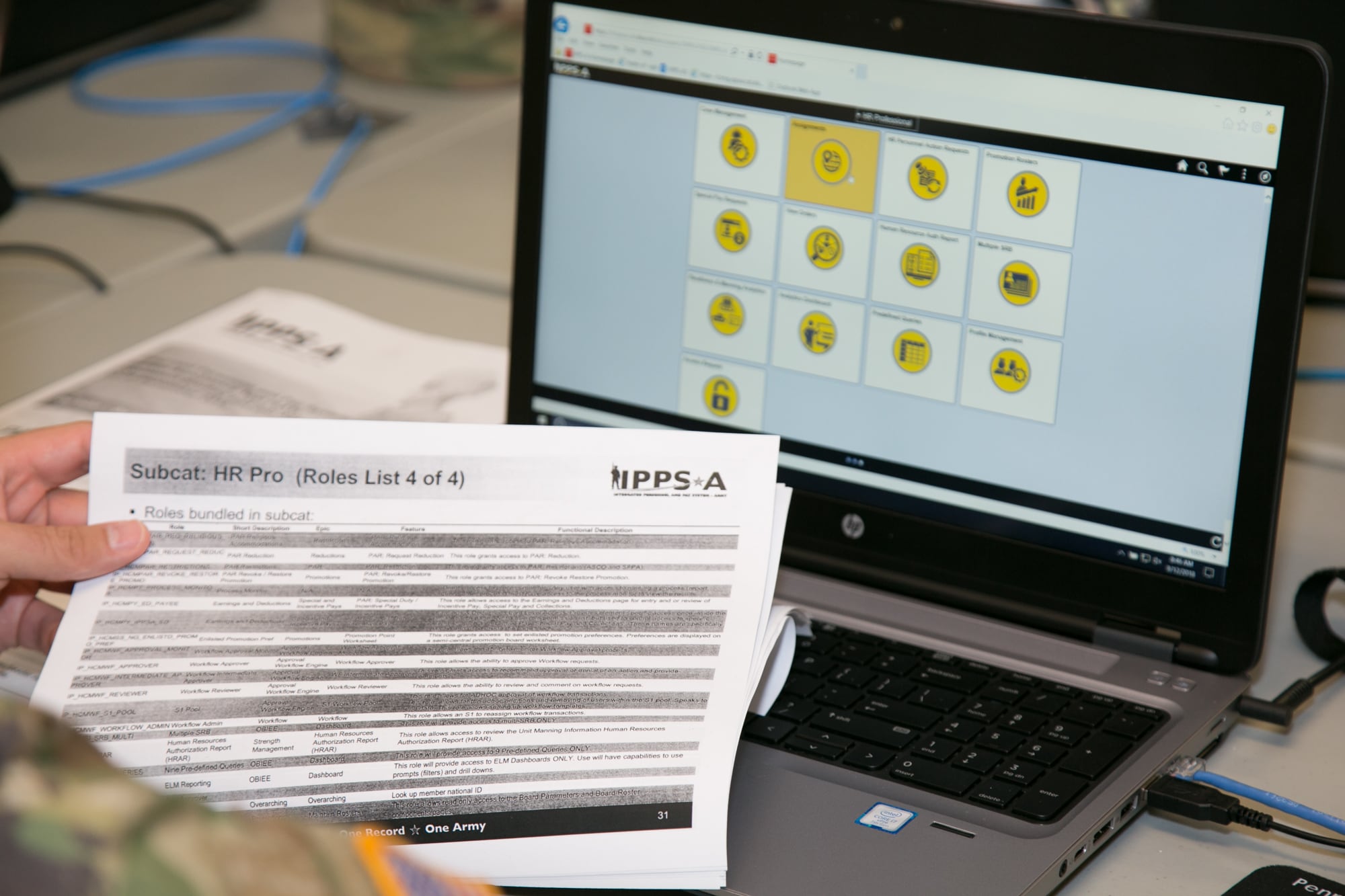
“I would [tell impacted soldiers] to stop and see their friendly neighborhood S1,” Anderson said, referring to personnel offices by their staff abbreviation. “They can either make that edit directly, or they can submit [a] customer relations management ticket to make that happen.”
The good news, Anderson said, is that “those fixes should become increasingly less necessary.” New soldiers’ data will be correct from day one, because the new system can accurately reflect names. Once current troops with impacted names either correct them or leave the service, the problem of misspelled and misformatted names will be permanently solved.
Anderson, also a retired National Guard lieutenant colonel, celebrated the upgrade to “a more robust system that is able to capture the diversity and the heritage of our workforce and give the soldiers the kind of respect that they deserve.”
“Being able to accurately reflect your name, that’s kind of important,” Anderson said. “It’s foundational to soldiers’ identity.”
Echoing Anderson’s reasoning, lawmakers and experts who spoke with Military Times said they were shocked and frustrated to learn that the name formatting problems persisted for so long due to legacy database restrictions.
‘Forced assimilation’
Manuel Pérez Quiñones, a professor of information systems at University of North Carolina at Charlotte, has written on the disconnect between dual Latino surnames and databases.
Over the years, Pérez Quiñones has run into database troubles in civilian life when his dual surname was entered into human resources systems. He explained that most databases have data validation features, or “error checks.” This is where programmers, among whom heritages with dual surnames aren’t the norm, can tell the system to reject certain kinds of characters.
The solution is simple, Pérez Quiñones argued. A space between two names should not be flagged as an error, he said.
The Air Force mandated such a change in 2021 after a Puerto Rican airman wrote a letter to senior officials about the importance of the spaces in his last name.
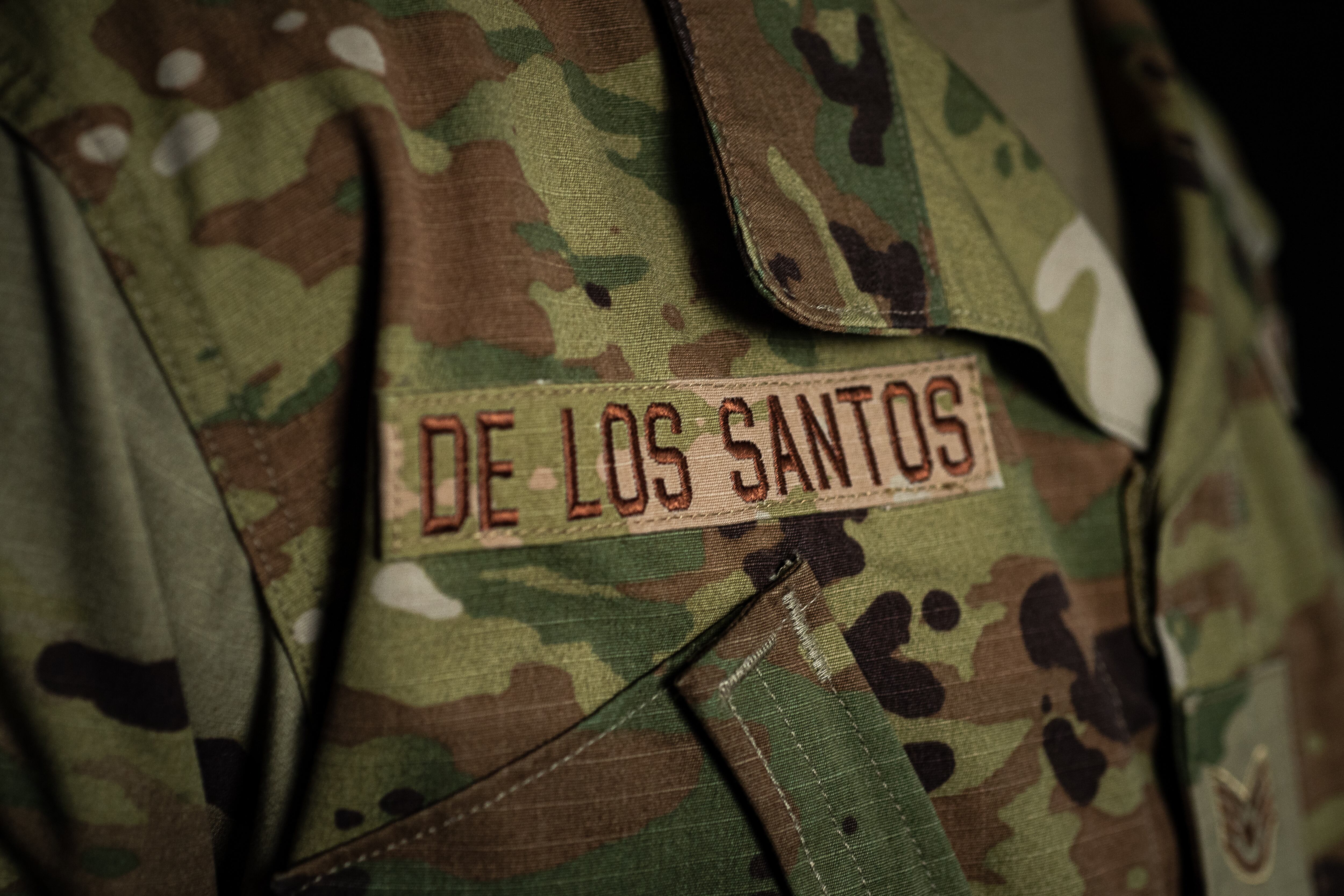
For communities whose heritage includes such surnames, the stakes are higher than just a data formatting error, the professor added.
“It is part of our culture, just that simple,” Pérez Quiñones told Military Times. “Forcing me to change my name is a form of forced assimilation that is really not needed. But more importantly, it reflects a focus on family.”
A last name — or “apellido” — carries great importance in Latino communities, according to a McGill International Review report by Maria Yacolca Maguiña. The author writes that “family name” is a better translation for apellido in order to better understand this common occurrence in Latino communities.
After all, Yacolca Maguiña writes, the existence of two “apellidos” denotes the importance of both family names. Such a practice symbolizes the union between two bloodlines.
Pérez Quiñones agreed.
“[The plural apellido] reinforces that the family is a union of two individuals and puts the focus on the kids, not the parents,” he said, describing the practice as “very common.”
Yacolca Maguiña offered an example.
If María García Morales and Miguel Gonzáles Hernández have a child named Valeria, the child’s birth certificate would read Valeria Gonzáles García. The first surname is the father’s family name, and the second is that of the mother.
For Rep. Gabe Vasquez, D-N.M., there is importance and meaning in a last name. He echoed Pérez Quiñones’ sentiments in an email to Military Times, saying dual surnames in Latino communities honor the lineage of both parents.
“When your heritage, culture and language are not the norm, these mistakes will continue to happen because those with authority lack the context and awareness to look for errors when reviewing official documents,” Vasquez said. “As one of the few Latinos on the committee, this weighs heavy on me for our servicemembers and veterans.”
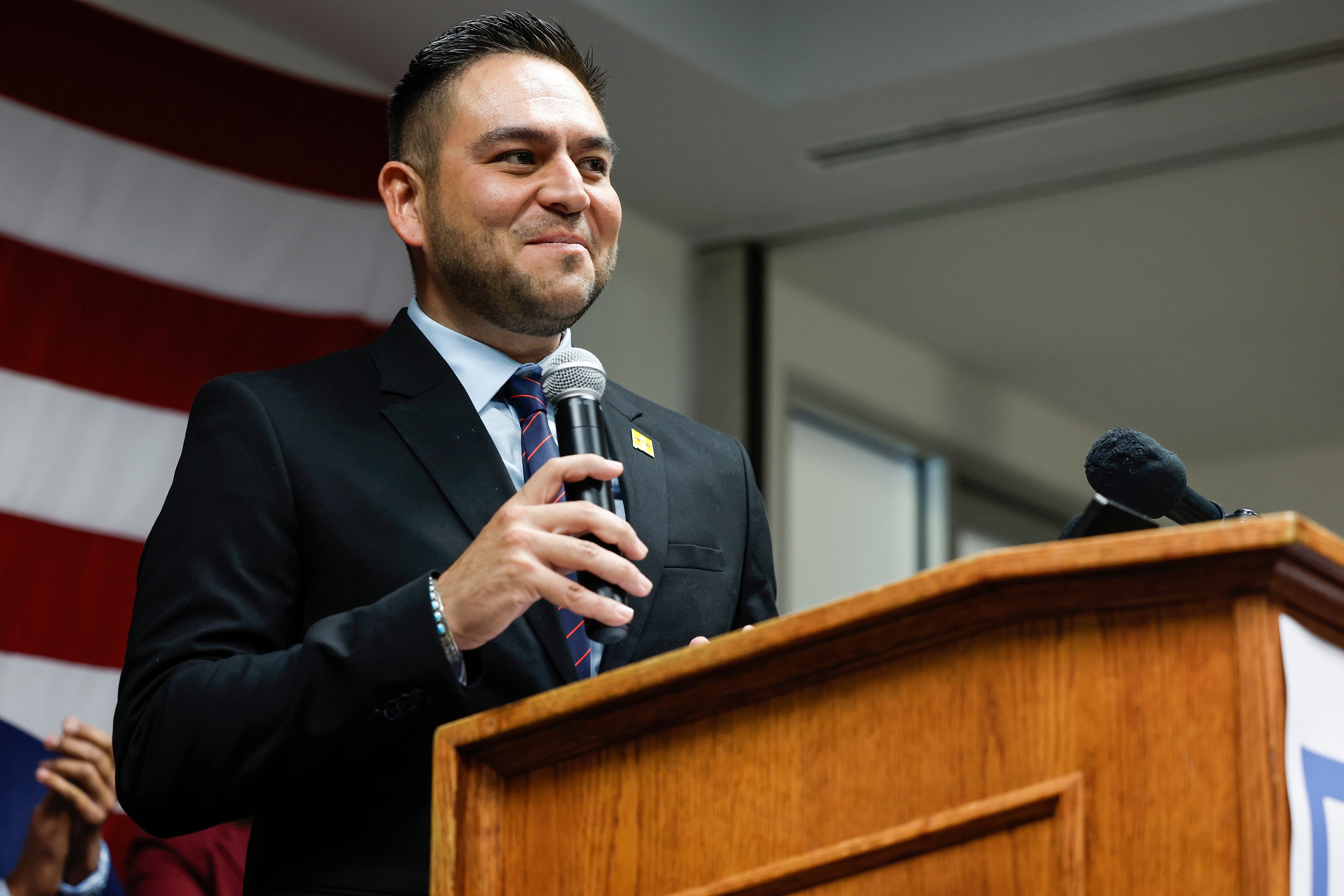
Vasquez, who is one of five Latinos on the House Armed Services Committee, said he has faced trouble with his own name being misspelled — or mistaken for another name altogether.
At a time when military services face a recruiting crisis, Vasquez noted, the services should promote “attention to identity” to make service members from a variety of backgrounds feel welcomed in the armed forces.
All services — with the exception of the Space Force and Marine Corps — missed their recruiting marks for fiscal year 2022. The Army in particular missed its recruiting goal by 15,000 soldiers last year — and anticipates it will fall short of its 2023 goal by 10,000 soldiers
Rep. Tony Gonzales, R-Texas, a retired master chief petty officer in the Navy, told Military Times in a statement that troops deserve to have their service properly memorialized.
“I completely support the bipartisan, bicameral effort to investigate why thousands of soldiers have had their sense of identity and heritage misconstrued,” Gonzales said, noting that the errors disproportionately impact “minority veterans.”
“I hope that the investigation gets to the root of how and why these inexcusable errors occurred and that the names of each soldier affected are corrected,” he added.
Rep. Ruben Gallego, D-Ariz., struck a similar note as Gonzales, his sea service colleague, in a statement to Military Times. The Marine Corps veteran was blunt.
“DoD needs to own its mistake and correct the issue with its databases,” Gallego said.
An error-riddled remembrance — still
Yet the department took three months to respond to lawmakers’ concerns about the problems with the Korean War wall, amid pressure from policymakers, advocates and allies alike. That included South Korea’s veterans ministry, which vowed in January to fix misspelled and missing names on the new wall.
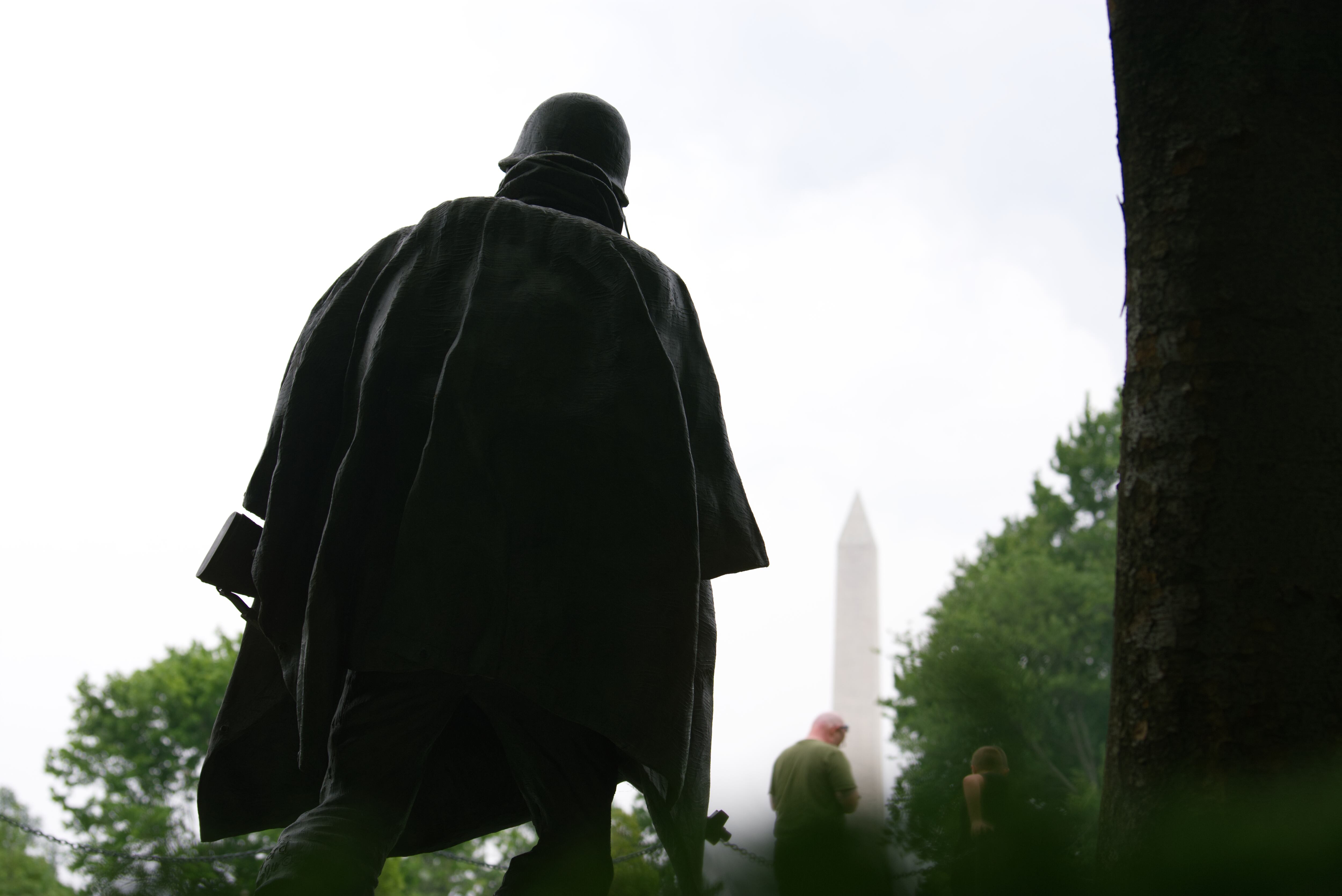
The Pentagon’s response came via a June 2 briefing to committee staff members, according to a defense official and House Natural Resources Committee Communications Director Rebekah Hoshiko.
It’s not clear what Pentagon officials told staffers in that meeting, but Hoshiko previously told Military Times that if the military shook off oversight from Congress, a “legislative solution” could be on the table.
In the briefing’s wake, Hoshiko added that the memorial’s name problem “continues to be a concern for the committee and we will remain engaged until all issues with the wall are fixed.”
And members are signaling their willingness to pursue such a solution, if necessary.
Vasquez, the New Mexico lawmaker, committed to “working to correct the historical databases.”
At least one member of the upper chamber is ready to take action as well. Sen. Tammy Duckworth, D-Ill., told Military Times that she’ll throw her weight behind “the best and fastest way” to correct the errors.
Some advocates — such as Noemí Figueroa Soulet, who wrote and directed a 2007 documentary on Puerto Rico’s 65th Infantry Regiment during the Korean War — remain frustrated that it’s come to this, though.
When Figueroa Soulet learned of the formatting problems that would disproportionately impact Puerto Rican dead, she contacted the Korean War Veterans Memorial Foundation and the Defense Department in an effort to fix the names.
“They were given an opportunity to get it right from the beginning,” she said in a phone interview with Military Times. “So it’s really shameful that they now have to spend money to fix what they were told they should fix from the beginning. It’s ridiculous.”
Davis Winkie covers the Army for Military Times. He studied history at Vanderbilt and UNC-Chapel Hill, and served five years in the Army Guard. His investigations earned the Society of Professional Journalists' 2023 Sunshine Award and consecutive Military Reporters and Editors honors, among others. Davis was also a 2022 Livingston Awards finalist.
Zamone “Z” Perez is a reporter at Military Times. He previously worked at Foreign Policy and Ufahamu Africa. He is a graduate of Northwestern University, where he researched international ethics and atrocity prevention in his thesis. He can be found on Twitter @zamoneperez.
